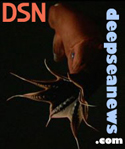 During my recent trip to Bonaire, I was lucky enough to be there during a coral spawning week. I've had the good fortune of seeing coral spawn before in Hawaii and along the Great Barrier Reef. But I've always been in the wrong place at the wrong time to see a Caribbean spawning event.
During my recent trip to Bonaire, I was lucky enough to be there during a coral spawning week. I've had the good fortune of seeing coral spawn before in Hawaii and along the Great Barrier Reef. But I've always been in the wrong place at the wrong time to see a Caribbean spawning event. Fortunately, Bonaire is such a popular and well visited dive destination that residents have their reef spawning down to the hour. I kid you not. Click on the chart to the left to get the full rundown on corals and other reef invertebrates that were scheduled to release their gametes en masse. While hard and soft corals prefer to get their groove on under cover of night, other randy inverts such as certain species of sponges, worms, and echinoderms are content for a little afternoon delight, beginning their spawning around midday.
Fortunately, Bonaire is such a popular and well visited dive destination that residents have their reef spawning down to the hour. I kid you not. Click on the chart to the left to get the full rundown on corals and other reef invertebrates that were scheduled to release their gametes en masse. While hard and soft corals prefer to get their groove on under cover of night, other randy inverts such as certain species of sponges, worms, and echinoderms are content for a little afternoon delight, beginning their spawning around midday.What triggers the mass spawning? Primitive light-sensing pigment mechanisms known as a cryptochromes, which occur in corals, insects, fish, and mammals - including humans - are the genetic trigger. First isolated by researchers from the ARC Centre of Excellence for Coral Reef Studies at the University of Queensland, Australia, the Cry2 gene is stimulated by the faint blue light of the full moon and appears to play a central role in triggering the mass coral spawning event. Mass spawning is an annual to biannual event and typically observed anywhere from three to ten days following a full moon. Coral colonies appear to experience at least two major "waves" of gamete release during a spawning event.
I managed to gather a group of divers one evening during the peak of Bonaire's spawning to head out for the reef love-fest. Props go out to my dive buddies for their enthusiasm, especially considering it was the first ever night dive for two of them! We headed out from the shore, flashlights and cameras ready. On the swim to the reef we were buzzed by enormous tarpon that flashed into view just inches from us to snatch-up any fish attracted to the lights. Once at the reef drop-off we began descending along the reef slope looking for any sign of spawning. Most hard coral species extend their fleshy polyps at night in order to feed. Spawning can look like an underwater snowstorm of eggs or egg/sperm packets percolating from a coral colony. Or it can look like puffs of smoke (sperm) being emitted.
We made several passes over colonies of Greater Star coral (Montastrea cavernosa) at about 50 feet and then noticed one colony appeared smokey. Hovering close I saw clusters of 20-30 polyps at a time contract and squirt a pale-colored puff of sperm into the water. Signaling with my light to others, we all gathered around to watch the event. In reaching for my camera, I brought it to my mask only to notice it had flooded. I decided to panic after the dive. I was witnessing a natural wonder.
Luckily, one of my dive buddies (Denise Mattia, a journalist on assignment from New York City) had a professional camera rig and managed to snap at least two shots of the event. While she didn't capture the actual "squirt," you can clearly see the cloud of sperm gathering above the colony. We were down for a little over an hour total and all returned to shore only to compare excited impressions of the spectacle.
If it meant having to kill my camera in order to see it, I think I'd gladly do it all again!


















1 comment:
Awesome (though still sorry to hear about the camera)!
My only coral spawning event was in Roatan in 1992, but I've had the voyeuristic pleasure of watching many of the other inverts and reef fish spawning. Nothing quite like sipping on a rum, sitting on a dock and watching a bioluminescent orgy unfold inches below you in the water...except being in the midst of it.
Post a Comment